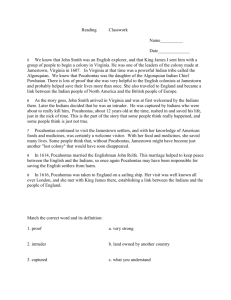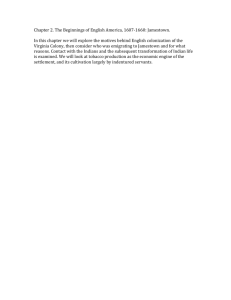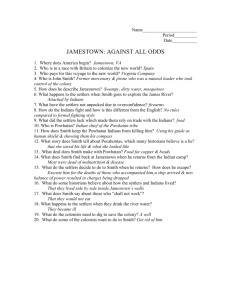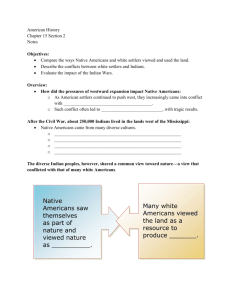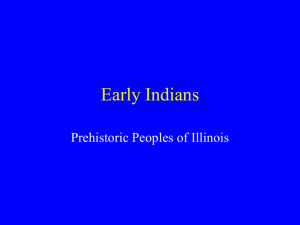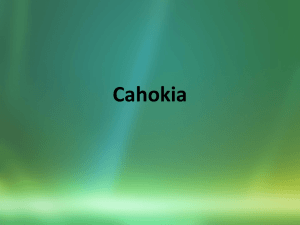APUSHIntroPowerpoint2015
advertisement
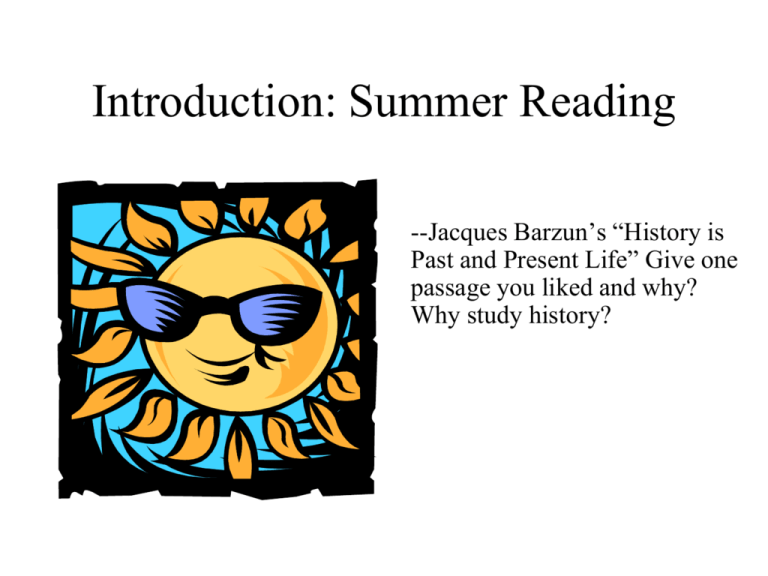
Introduction: Summer Reading --Jacques Barzun’s “History is Past and Present Life” Give one passage you liked and why? Why study history? Summer Readings, continued… • Mark Noll’s “A Christian America?” Is it, or isn’t it? Do you agree? • Harry Stout’s “Biography as Battleground” What are the three levels of historical analysis? Why is this important in studying history? Whose biography would you like to write? • Also, what about George Marsden’s “A Christian Perspective for the teaching of history”? Summer Readings, cont… • Gordon Woods—”The Localization of Authority in the 17th century English Colonies—New England & the Chesapeake • Primary Sources—”From Attics to Graveyards” Possible topics/sources? See poster • Bedford Readers? • History book reviews? Introduction to U.S. History A. What is U.S. History and how do we study it? --Definitions? 1. Understand the importance of: Place, Time, and People (and the records they make) 2. Use sources to discover facts and make interpretations Primary (letter) vs. Secondary (textbook) and non-written *Read sources carefully and critically, for author’s viewpoints, bias, context, etc… 3. Know key dates, periods, institutions and figures (somewhat selective) --Dates are “pegs” (Barzun) i.e., 1776, 1865, 1914 --Periodization: division of history: i.e. Federalist Era, Jacksonian Democracy, Era of Good Feelings, Great Depression --Institutions—Houses of Congress, Supreme Court, Military branches, Churches, Corporations, --Key Figures: i.e. Presidents, military leaders, reformers, inventors, but also the lesser-known figures. 4. Ask questions • Questions of fact: What? When? Where? Who? How? • Questions of interpretation: Why? How? • Questions of causality or relationships (cause and effect) • Hypothetical questions: What if? • Questions of judgment: Was it good? Bad? Justified? Unjustified? 5. Deal with historical debates/controversies, i.e.… • Was Christopher Columbus a hero or a villain? • Was the Revolutionary War justified? • Why did Reconstruction fail? • Why did so many people in America not have civil rights? • The war on terror: success or failure? 6. Address themes and issues throughout U.S. history EXAMPLES: •American Exceptionalism •Order vs. Liberty (National Government vs. States’ Rights) •Freedom vs. Equality •Unity and Diversity •Christian vs. Secular •American Idealism vs. Realism •Isolationism vs. International involvement • AP 2015 Themes 1. American and National Identity 2. Politics and Power 3. Work, Exchange, and Technology 4. Culture and Society 5. Migration and Settlement 6. Geography and the Environment 7. America in the World B. The First “Americans” 1. Native Americans/Amerindians by 1492 (Probably arrived up to 10,000 years ago from Asia on a land bridge across the Bering St.) a. Estimated population: 16-20 million, only 12 million in sparsely settled future U.S. b. Variety of tribes--about 500 languages and many tribes c. South and Central America developed more civilizations: i.e. Mayas, Aztecs, Inca 2. The mound builders of North America such as the Hopewell and Mississippian (Cahokia) Artifact – object made by humans and used by archaeologists to recreate a picture of the past. Cahokia Point. Cahokia Point. Cahokia Point. Bone Point. Triple Notch. Serrated Edge. Double Notch. L: 1.5" L: 1.25" L: 1.75" L: 2" Cahokia Mounds Cahokia Mounds Cahokia Mounds Cahokia Mounds Madison Co., IL. Madison Co., IL. Madison Co., IL. Madison Co., IL. Flint Shark Tooth Point. L: 1" Cahokia Mounds Madison Co., IL. The Missouri Heron Pipe. H: 5.25" Made from red to brown banded slate. This well-known bird pipe was discovered in 1858 by a farmer named Amos Weiling while removing a tree stump on a farm in Mew Madrid County, Missouri. The heron is a common sight along the waterways in central and southern Missouri. The Dr. Bunch Frog Pipe. L: 8.25". Made from fine green sandstone. This famous pipe was found in 1878 in a low mound on a river bluff near what is nows Bluffton, Yell County, Arkansas. Mound Builders • The Mound Builders, including the Hopewell and Mississippian peoples, lived from about 3,000 years ago to the 1700’s. • Early mounds were burial grounds for important leaders. Miamisburg, OH Adena people Great Serpent Mound, Ohio • The Mississippian people build the city of Cahokia in present-day Illinois. • The largest mound of Cahokia was Monk’s Mound, which covered around 16 acres. • The fence build around the city served as a calendar. • The posts of the fence were viewed from the top of Monk’s Mound. - shorter shadows meant the coming of spring - longer shadows meant the coming of autumn * This system allowed farmers to know which crops should be planted. 3. Native Americans in the West. • Many Indians in the West--i.e. Anasazi, Navajo, Apache, Pueblo, Nez Perce, Blackfoot, Sioux. I. Unit One: Colonial America A. Background: The Discovery of the New World 1. Earlier explorations or the North Atlantic: Confirmed: Norse/Viking--Eric the Red in Newfoundland Debated: St. Brendan? Basques? Chinese? 2. Europe’s growing military capabilities and wealth by 16th century. 3. The Effects of the Renaissance and Reformation 4. Newly-unified nations (and monarchies), with ambitions of trade and empire: i.e, Spain, Portugal France, England, Netherlands, Sweden. 4. First Impressions: Christopher Columbus What was Columbus’ impression of them? Why Africans and not native populations? How did the Spanish treat them? What did Las Casas reveal? 5. Spain and Portugal Lead in the Age of Exploration a. Allure of the “treasures” of Asia b. Importance of Italian mariners: Christoforo Colombo, Vespucci, Caboto, Verrazano, c. Portugal and the African Route to Asia d. Spain and the Discovery of the New World. e. Results of the “Discovery”: Precious metals (Au and Ag), “Columbian Exchange,” encomienda system, slavery, both African and native, Roman Catholicism, interracial marriage f. Debate about Columbus and other conquistadors B. Non-English Exploration and Colonization of North America 1. Spanish South (FL-CA) --First permanent settlement in N. America was St. Augustine in Florida by Ponce de Leon --Cortes in Mexico by 1520, and Juan Sebastian Cabrillo in California by 1542, and Manila Galleon silver route established by 1570 2. New France—Veraz. explores, Jacques Cartier establishes Montreal and Quebec, Marquette and LaSalle explore Great Lakes and Mississippi R. --French Bourbon crown relatively uninterested in settling. Mainly for fur trade, and only for Catholics (though Fr. Hugenots settled in Florida 3. New Netherlands (NY). Peter Stuyvesant, 1613 4. New Sweden--(DE) Peter Minuit, 1638 C. English Exploration and Colonization 1. Reasons for English colonization: • • • • • • • Trade and econ dissatisfaction/poverty Surplus population (overcrowded prisons, too) National rivalry and glory (Drake, etc..) National econ. policies: Mercantilism Glorification of the monarchy Religious freedom and persecution Many other individual reasons… 2. Native Americans in North American colonies The most important Native American tribal groups to the early settlers were those in the Southeast (Creek, Choctaw, Cherokee, etc…) and the Northeast (Algonquian, Iroquois, etc.) Some, like the Algonquian and Iroquois, were tradition enemies. Algonquian drawn by 3. Turbulent 17th Century England a.Tudor Monarchs: Queen Elizabeth (1558-1603) (“Virginia”) b.Stuart Kings: James I (1603-1625) and Charles I (1625-1649) c. Civil War developed between the Roundheads (Protestants) and Cavaliers (Cath.) and Oliver Cromwell as Lord Protector d.The Restoration: In 1660, Monarchy restored-Charles II (1660-1685) and James II (1685-1688 e.The Glorious Revolution: James II, a Catholic removed and William and Mary, Protestants, placed on the throne **Results of Glorious Revolution --Parliament becomes more powerful --Bill of Rights, 1689 --Toleration Act (for most Protestants, not for Catholics, 1689 --Locke’s Two Treatises on Government, 1689 --Expansion of slavery (no more state monopoly on slave trade after 1695) 4. First Attempts at Colonization a. Prior colonization of Ireland-Sir Humphrey Gilbert. Treated Irish harshly (comp. Indians) b. Early explorers--John Cabot (1497) and Newfoundland, and Sir Humphrey Gilbert (1570s1580s) in North Atlantic/Canada c. Roanoke--1584, Sir Walter Raleigh established Virginia (in N. Carolina). Location was poor (Outer Banks), Sir Richard Grenville, leader, destroys an entire Indian village and then leaves, and the rest leave in 1586 with Sir Francis Drake. Roanoke, the second attempt… • 1587, Raleigh tried again, and placed John White (talented administrator and artist) in charge, settling near Roanoke (Sketchbook of Algonquian Indians) • Between 1587-1590, communication was cut off (Spanish Armada blocked?)and when a ship finally came to “rescue” them, they had disappeared with word “CROATAN,” name of nearby island or Indian tribe, scratched into tree. ???? The mystery remains… 5. Jamestown and Virginia a. Problem of money. Solution: Joint-stock Companies (forerunner of corporations) Monarchs gave these companies (i.e. Virginia Company, Plymouth Company, Massachusetts Bay Company), charters to establish colonies. b. Shaky start: 16071617 The London Company (also called Virginia Co.), with Sir Thomas Smith, a wealthy merchant, as leader set out with 3 ships and 104 men to establish a fortified outpost miles up a large navigable river. Chose the James River. Bad choice--contaminated water, etc… But no immediate Spanish threat. Quarrels broke out. 50-50 chance of survival--high mortality First Thanksgiving, in Jamestown? c. John Smith --Men were not used to working and were greedy and expected to become rich quickly. When they stole Indian supplies, Powhatan cut off all supplies --John Smith seized control of ruling council in fall of 1608. Brought order to the anarchy of Jamestown by strict military discipline. Traded with Indians, mapped the Chesapeake (was captured by Powhatan Indians, one of the Algonquian tribes and may have been rescued by Pocahontas) John Smith…. • Smith, wounded in a gunpowder accident, returned to England in 1609 • 1609-1611--Lack of leadership, terrible winters-”the starving time.” In June, 1610, remaining settlers abandoned Jamestown, but forced to go back by the governor • Also, “gender imbalance” and high mortality rates continued. By 1622, 3000 immigrated, 1240 remained alive d. Pocahontas and John Rolfe • Pocahontas, Chief (Emperor?) Powhatan’s daughter • Incident of John Smith’s “rescue” or symbolical ceremony to make him a vassal? Read p. 51 in BSL • Captured by English ship in 1613 and married John Rolfe in 1614 • Rolfe was first to introduce tobacco farming to Virginia. Provided some successful product for VA, but K. James not enthused…until tax revenues arrive (Song—”Tobacco’s But an Indian Weed”) e. 1619: Two “Firsts” 1.) House of Burgesses-First Legislative Assembly in North America. Part of Sir Edwin Sandys reforms--a promised elective representative assembly. 2.) African Slavery:A Dutch ship arrived with slaves, captured from a Spanish ship in the Caribbean. Status of blacks was unclear-some were considered servants, some permanent slaves. f. War with Indians • 1622 Opechancanough, Powhatan’s successor, led surprise attack on the English settlers. Though warned by two Christian indians, 347 (one-third) of settlers died and the war continued for years • After two years, 500 settlers had died, but Opechancanough was captured, and the dwindling Indian confederacy (less than 2000) submitted to English rule. • 1624, as a result of the colony’s inability to deal with Indians and bankruptcy, the 1609 charter was removed, and VA became a Royal colony • 1644--Powhatans went to war again, but wiped out g. Violence in VA: Bacon’s Rebellion • Around1660, the economy had declined and created dissatisfaction. • Nathaniel Bacon, arrived in Virginia in 1674 and became a planter, but didn’t like the patronage and gentry inequality--lucrative commerce reserved for the Governor Berkeley’s friends, etc… • Indian uprising in 1675, but Governor responds by building forts to protect himself in Jamestown. But what about the settlers outside Jamestown? Bacon…continued • Bacon offers to lead a --Led to Virginia gentry working volunteer army to fight the together to heal divisions--Never Indians, but the governor to allow such a rebellion again. refuses. Bacon appeals to populace, and marches to frontier (but failed to find Indians) • He burns Jamestown, forcing the governor to flee, and civil war breaks out • By October 1676, Bacon died and the rebellion was over. h. Society in VA and the Chesapeake --Social classes: Royal Governor, Gentry, Freemen (“headright” 50 acres), Indentured servants, Slaves (black codes instituted by late 17th c.) --Scattered plantations and few towns. Victory over Indians helped to encourage the spread of settlers --High mortality rate, thought improved somewhat by late 17th c. when life expectancy increased --Education: William and Mary (1693), but general lack of education (gentry children sent to England) --Religion: Mainly Anglican, but not well organized 6. Maryland • Very similar society to Virginia • Proprietary colony founded by Lord Baltimore (George Calvert), a Catholic Englishman as a haven for English Catholics • By 1700 had about 25,000 people, many non-Catholic 7. Pilgrims and Plymouth (1620) a. b. Journey from Scrooby to Netherlands to Plymouth Mayflower Compact and William Bradford: c. Hunger and debt d. Squanto and Indians e. Merged with Massachusetts Bay Colony in 1691 8. Puritans and Mass. Bay Colony (1630) a. Puritans and the Church of England (remember history of England) b. Independent charter for Mass. Bay Co. c. Gov. John Winthrop-”City on a Hill” d. Great Migration: 2000 after 1st year and by early 1640s more than 16,000 e. Concept of Covenant important to Puritans Puritans and New England, cont… f. Women in New England. Many views on their status. g. Rank and Status in New England Society Most were yeoman farmers. Not many indentured servants or slaves h. Family life key for society and education from the beginning. i. Government--All freemen (and members of Congregational Church) could vote (over 40%) j. Towns as centers of Puritan communities. k. Education: Harvard (1636) and other schools l. John Eliot: “Apostle to the Indians” (1604-1690) • Instrumental in education, conversion of Massachusetts’ Indians • Translated and printed Bible into Native language in 1663 • Built 14 Indian “Praying towns” • Protested harsh treatment of Indians 9. Roger Williams and Rhode Island (1636) a. Disagreement with Puritan government: --Extreme separation of Church/State --No right to punish for religious beliefs (religious tolerance) --Rights of Indians not considered in charters b. Anne Hutchinson 1638, joined him after she was kicked out. Criticized clergy and said she received direct inspiration outside of Bible/clergy --Church concerns: antinomian and subjectivism c. Rhode Island became a royal colony in 1663 and attracted many groups including Jews, Quakers, etc... 10. Other New England Colonies a. New Hampshire (1623)--small and scattered proprietary colony given as a gift from the King to John Mason. Became a separate colony from Mass. in 1677. b. Connecticut: Two major colonies: --Hartford founded by Thomas Hooker in 1636, a Congreg. Minister. Fundamental Orders of Gov’t, a state constitution that allowed nonPuritan/ Congregationalists to vote --New Haven taken over by Connecticut in 1662, but originally established by Theophilus Eaton and John Davenport. Strict, but important port 11. Conflicts in late 17th c. New England a. Religious conflict (i.e. “half-way covenant”) b. King Philip’s (Metacomet) War--1675 c. Unpopular Colonial Administrative Policies from England 1684--Massachusetts’ charter revoked and new division of English colonies in only TWO sections in 1686, but lasted only until 1691 (after the Glorious Revolution restored the original colonial charters) --Navigation Acts from 1695 try to further restrict trade d. Salem Witch Trials in 1692 12. New York • New Netherlands originally owned by the Dutch • Many ethnic groups settled, also introduced slavery in 1626 --Poor leadership, i.e. Peter Stuyvesant --Duke of York (later James II) brother of Charles II, was given, along with other lands, including lands in Maine --“Duke’s Laws” 1665 guaranteed religious freedom and local gov’t, but no elected assembly. 13. New Jersey • Given as gift to two of courtiers by Duke of York, Lord Berkeley and Sir George Carteret, but New York governor Nicolls was upset • Chaotic settlement and little profit because of a lack of a good harbor • Berkeley sold sold rights to a group of quarrelsome Quakers and it was divided into East and West Jersey 14. Pennsylvania--”Penn’s Woods” a. George Fox and the Quakers/Society of Friends b. Penn’s “Holy Experiment” 1681 Charles II a. b. c. Frame of Government-1682 (same year Delaware purchased from Duke of York)--set up assembly and established freedom of conscience, etc… Promotion of Settlement--Very diverse: 100,000 Irish, 65,000 Protestant Germans Econ. Success, but divided. Penn signs Charter of Liberties, and dies depressed and indebted. 15. Carolinas • Product of the Restoration (1660) • Charter to various proprietors, under Sir John Colleton of Barbados with three main jurisdictions: Abermarle (NC), Cape Fear River, Port Royal Region (SC) -Barbados connection • Settlement difficulties • Charleston (Charles Town)--est. in 1670 --John Locke wrote Fundamental Constitution of Carolinas--not very effective constitution and generally gov’t was incompetent. --Slavery was very important in the economy --Conflict and creation of N. and S. Carolinas—1729 16. Georgia • Spanish claims from Florida. Georgia was a boundary between Spanish and English colonies. • 1733--James Oglethorpe, “Our Perpetual Dictator” Military rule by this general and parliament member • Asylum for poor and those in debtor’s prison • Limitations for settlers, I.e. no slavery , no rum, limited land and primogeniture. By 1750 these laws were gone. D. Slavery in the Colonies 1. 11 Million to Americas 2.English Slavery 3.Slave Codes by 1700 4.The South’s reliance on slavery, in 18th c. S.C.=60% VA=40% PA=8% MA=3% 5. Black sailors, by 1803=18% 6. Newly-arrived Slaves (from Africa) versus creoles (native-born) 7. Stono Rebellion Sept. 1739 a. b. 150 Blacks murder several white planters and total of 20 whites Head towards Spanish Florida, but caught by militia and most are killed.

